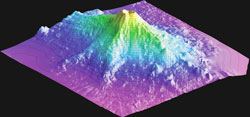Sustainable energy source could solve Bermuda Triangle riddle
Experts at Cardiff University, UK, have designed world-first technology to investigate sustainable energy sources from the ocean bed by isolating ancient high-pressure bacteria from deep sediments.
Scientists and engineers at Cardiff University are investigating bacteria from deep sediments which despite high pressures (greater than 1,000 atmospheres), gradually increasing temperatures (from an icy 2°C to over
Human activities are causing ocean temperatures to rise, according to a paper published in the American journal Science on 3 June, 2005.
Tim Barnett, the lead author on the paper said: ‘The evidence, based on computer models and observations in the field, is so strong that it should put an end to any debate about whether humanity is causing global warming.’
In the paper the scientists describe how they have been able to rule out natural climate variability and solar or
For Tadeusz Molinski, the sea is full of riches — and he does not mean oil fields or fisheries. Molinski, a professor of chemistry at the University of California, Davis, is searching for new treatments for cancer, infectious diseases and other conditions that could be made from natural products in the soft bodies of some of the ocean’s simplest inhabitants.
“Three quarters of the world is covered by oceans, and we’ve only dipped below the surface,” Molinski said.
Deep within Earth, researchers are finding hints of exotic materials and behaviors unrivaled anywhere else on the planet. Now a team of researchers is making connections between the dynamic activities deep inside Earth and geologic features at its surface.
The researchers, which include two seismologists from Arizona State University, have detected a relatively small and isolated patch of exotic material, called an ultra low velocity zone (ULVZ), that may in fact be a “root” for m

Woods Hole Center for Oceans and Human Health cruise provided timely data for shellfish managers
With shellfish beds from Maine to the Cape Cod coast closed from the largest outbreak of red tide in 12 years in Massachusetts Bay, scientists from the Woods Hole Oceanographic Institution (WHOI) are studying the algae that causes these “red tides” and providing information to coastal managers using new molecular techniques and oceanographic models.
After a recent research cr

An international team of scientists, led by researchers at the Woods Hole Oceanographic Institution, Scripps Institution of Oceanography, University of Oregon and University of Sydney, has discovered an active underwater volcano near the Samoan Island chain about 2,400 miles southwest of Hawaii.
During a research cruise to study the Samoan hot spot, scientists uncovered a submarine volcano growing in the summit crater of another larger underwater volcano, Vailulu’u. Research